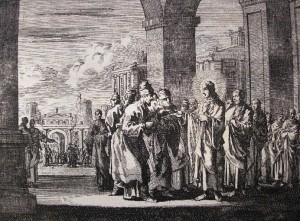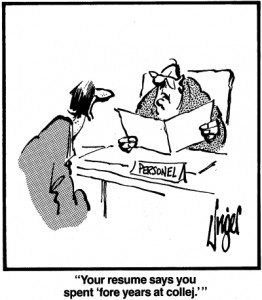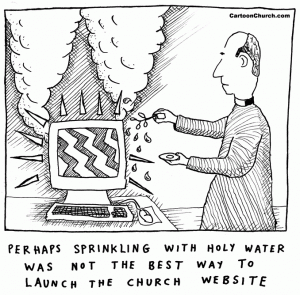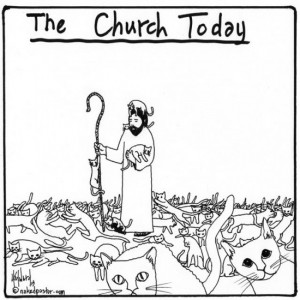From John’s Gospel:
Now among those who went up to worship at the festival were some Greeks. They came to Philip, who was from Bethsaida in Galilee, and said to him, “Sir, we wish to see Jesus.” Philip went and told Andrew; then Andrew and Philip went and told Jesus.
(From the Daily Office Lectionary – John 12:20-22 (NRSV) – March 1, 2014.)
 This is such a great set up! Here are these Greeks (whether gentiles or Greek-speaking Jews of the Diaspora is unclear) who want to meet Jesus. They come to Philip who apparently speaks Greek and make their request. He goes to Andrew (another unclear thing: does he take the Greeks with him?) The two of them go see Jesus (with the Greeks?)
This is such a great set up! Here are these Greeks (whether gentiles or Greek-speaking Jews of the Diaspora is unclear) who want to meet Jesus. They come to Philip who apparently speaks Greek and make their request. He goes to Andrew (another unclear thing: does he take the Greeks with him?) The two of them go see Jesus (with the Greeks?)
Now, how will Jesus respond?
If the Greeks are gentiles, will he respond as he did to the Syro-Phoenician woman: “It is not fair to take the children’s food and throw it to the dogs.” (Matt. 15:26)
Will he respond as he did to the centurion who sought healing for his servant: “Truly I tell you, in no one in Israel have I found such faith.” (Matt. 8:10)
If they are Jews, will he remind them of the Law as he did the rich young man who asked about eternal life: “You lack one thing; go, sell what you own, and give the money to the poor, and you will have treasure in heaven; then come, follow me.” (Mk. 10:21)
Will he welcome them and invite them to eat with him as he did the tax collectors and sinners? (Luke 15:1-2)
Uh . . . no. Not John’s Jesus. John’s Jesus goes off on some entirely self-centered tirade about glorification and grain dying and eternal life and his soul being troubled! John’s Jesus doesn’t respond to Andrew or Philip or the Greeks at all! I swear, there are times when Jesus as portrayed in the Fourth Gospel seems to be somewhere on the autism spectrum; his answers to inquiries are so far removed from the subject of the question one wonders if he even heard what was asked, or knows or cares who is asking. (This is one of those times!) Is this an accurate portrayal of the way Jesus interacted with people? Can this be historically factual?
So here’s my thought: the Jesus of the Fourth Gospel is not the historical Jesus. This Jesus is John’s attempt to communicate the spiritual nature of the resurrected and ascended Lord; this Jesus is a mystical reality not an historical portrait. L. William Countryman in The Mystical Way in the Fourth Gospel called Jesus’ strange, almost non-responsive, frequently offensive dialogs “obnoxious.” Although that’s a good description, I think they are almost hallucinatory. They twist the reader’s understanding of reality and open the reader’s mind to new possibilities. Would you see Jesus? Then consider a kernel of grain and how its life increases even though it dies? Would you see Jesus? Then follow Jesus, do as Jesus does, do what Jesus teaches. Would you see Jesus? Then listen for the voice of the Father. Jesus’s answers seem non-responsive, but they are gateways to new appreciations.
====================
Father Funston is the rector of St. Paul’s Episcopal Church, Medina, Ohio.
 The words of Caiaphas the high priest are reported by John as a prophecy that Jesus’ death would be an atoning sacrifice, that he would “die for the nation, and not for the nation only, but to gather into one the dispersed children of God.” (vv. 51-52) But I read them this morning as nothing more than political calculation.
The words of Caiaphas the high priest are reported by John as a prophecy that Jesus’ death would be an atoning sacrifice, that he would “die for the nation, and not for the nation only, but to gather into one the dispersed children of God.” (vv. 51-52) But I read them this morning as nothing more than political calculation.  My favorite thing in the Book of Proverbs is the personification of Lady Wisdom. Perhaps because of the further development of her portrait in Chapter 8, where she is said to have been with God in the moments of creation, “daily his delight, rejoicing before him always, rejoicing in his inhabited world and delighting in the human race” (vv. 30-31), I see her as young, slender, and athletic, her rejoicing being manifest as dance.
My favorite thing in the Book of Proverbs is the personification of Lady Wisdom. Perhaps because of the further development of her portrait in Chapter 8, where she is said to have been with God in the moments of creation, “daily his delight, rejoicing before him always, rejoicing in his inhabited world and delighting in the human race” (vv. 30-31), I see her as young, slender, and athletic, her rejoicing being manifest as dance. It has been said that all human communication, even at its best, is an approximation of meaning. This is especially true of religious communication which is almost always analogic. When we try to speak of God we mean both more and less than we say; when we listen to others speak of God, we understand both more and less than we hear.
It has been said that all human communication, even at its best, is an approximation of meaning. This is especially true of religious communication which is almost always analogic. When we try to speak of God we mean both more and less than we say; when we listen to others speak of God, we understand both more and less than we hear.  A very familiar sentence from a very familiar story. I am intrigued today by the way in which Jesus carefully phrases his invitation to stone the woman caught in adultery. He does not say, “Let anyone among you who has not sinned be the first . . . .” Rather, “Let anyone among you who is without sin . . . .” As Jesus has phrased it, sin is not something done; it is a condition possessed. Those who would condemn the woman are focused on actions and behavior. Jesus turns their attention and their consciences from human behavior toward human nature.
A very familiar sentence from a very familiar story. I am intrigued today by the way in which Jesus carefully phrases his invitation to stone the woman caught in adultery. He does not say, “Let anyone among you who has not sinned be the first . . . .” Rather, “Let anyone among you who is without sin . . . .” As Jesus has phrased it, sin is not something done; it is a condition possessed. Those who would condemn the woman are focused on actions and behavior. Jesus turns their attention and their consciences from human behavior toward human nature. My grandmother was a great fan of that old shibboleth, “Don’t judge a book by its cover.” We all know what it means: you have to get to know someone (“read the book”) before you can make any judgment about them. “Appearances,” goes another, “can be deceiving.” Until you have worked passed and through the surface, you cannot know and make judgments about what lies underneath. Until, as the Native American teaching goes, you have walked a mile in another person’s moccasins, you have no basis on which to render judgment.
My grandmother was a great fan of that old shibboleth, “Don’t judge a book by its cover.” We all know what it means: you have to get to know someone (“read the book”) before you can make any judgment about them. “Appearances,” goes another, “can be deceiving.” Until you have worked passed and through the surface, you cannot know and make judgments about what lies underneath. Until, as the Native American teaching goes, you have walked a mile in another person’s moccasins, you have no basis on which to render judgment. Sunday, February 2, was significant for three things. It was the Feast of the Presentation of Jesus in the Temple, also called the Purification of Mary, also called Candlemas, a principal feast in the Christian faith and one that rarely falls on a Sunday. It was Groundhog Day, a very silly secular holiday in the United States and the inspiration for one of the more profound movies about personal growth and maturity, 1993’s Groundhog Day starring Bill Murray. It was Super Bowl Sunday.
Sunday, February 2, was significant for three things. It was the Feast of the Presentation of Jesus in the Temple, also called the Purification of Mary, also called Candlemas, a principal feast in the Christian faith and one that rarely falls on a Sunday. It was Groundhog Day, a very silly secular holiday in the United States and the inspiration for one of the more profound movies about personal growth and maturity, 1993’s Groundhog Day starring Bill Murray. It was Super Bowl Sunday.
 In a sense, we walk on the surface of chaos all the time. One of the learnings from quantum mechanics is that things are not nearly as solid as they seem. The everyday world seems to “float” on what has been called a “quantum foam.” The Greeks posited that if we continue to divide matter we get to atoms; if we divide atoms, we get electrons, neutrons, and other subatomic particles; if we try to divide subatomic particles, eventually we get to get quantum fields and even multidimensional vibrating strings. At the quantum level, reality is a quivering mass of quantum chaos. We walk on the surface of chaos all the time!
In a sense, we walk on the surface of chaos all the time. One of the learnings from quantum mechanics is that things are not nearly as solid as they seem. The everyday world seems to “float” on what has been called a “quantum foam.” The Greeks posited that if we continue to divide matter we get to atoms; if we divide atoms, we get electrons, neutrons, and other subatomic particles; if we try to divide subatomic particles, eventually we get to get quantum fields and even multidimensional vibrating strings. At the quantum level, reality is a quivering mass of quantum chaos. We walk on the surface of chaos all the time! Is it just me, or does this speech of Jesus (the verses are part of a long, long address to “the Jews”) just drip with frustration? And it makes me wonder – did Jesus really express such frustration? Or is it John who is frustrated and does his frustration color the way he presents the gospel story?
Is it just me, or does this speech of Jesus (the verses are part of a long, long address to “the Jews”) just drip with frustration? And it makes me wonder – did Jesus really express such frustration? Or is it John who is frustrated and does his frustration color the way he presents the gospel story? There are times when I’m reading one or another of the Gospels and I am pulled up short; I just have stop and say, “Really? Jesus said that? Really?”
There are times when I’m reading one or another of the Gospels and I am pulled up short; I just have stop and say, “Really? Jesus said that? Really?” 

